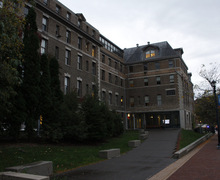Bus stops to install electronic, up-to-date arrival times
Electronic signs with real-time bus departure and arrival schedules may line several campus bus stops come spring.
The signs are part of a $2.25 million federal grant awarded to the Centro transportation organization Sept. 9 to update the bus system along the Connective Corridor, a cultural strip connecting Syracuse University to the downtown area.
When winter weather strikes, bus riders will be able to keep an eye on the electronic signs with departure and arrival times inside sheltered locations, said Steve Koegel, Centro’s director of marketing and communications.
The electronic signs could be beneficial to first-year SU students who don’t know where to find the bus schedules, said Delorian Sanders, a senior psychology and communication major.
‘You don’t want to walk all the way down the street just to see what time it comes,’ she said as she waited at the bus stop in front of Watson Hall around 5 p.m. with at least 10 others.
Anna Paterno, a freshman in the College of Visual and Performing Arts, has waited 25 minutes before schedule to catch buses on campus.
But with the electronic signs up, she said she could just come by and check the times and do other things while waiting for the buses.
‘Even if they are backed up, it’ll be more convenient to know when,’ she said.
GPS notification systems will also be installed on nearly 20 buses through the grant as a pilot program, which may be expanded beyond the Connective Corridor if they are successful, Koegel said.
‘It should be a tremendous convenience for the customer,’ Koegel said.
Sen. Charles E. Schumer (D-N.Y.), who helped land the grant money from the Federal Transit Administration, said in a press release the GPS systems would allow bus drivers to recognize and adjust to traffic issues in real time.
However, bus drivers will still need to watch the streets, Koegel said.
‘It’s not really designed as a driver assistance mechanism,’ he said. ‘We still rely on our drivers to watch the road.’
Centro is currently planning the placement of the technology and hopes to have the electronic signs and GPS systems running by spring 2011, Koegel said. Centro will place some of the electronic signs on the SU campus, but the exact locations aren’t determined yet.
Some of the grant money is also going toward building a new bus transfer hub in downtown Syracuse, which Centro hopes to have open by fall 2011, Koegel said.
Published on September 13, 2010 at 12:00 pm





